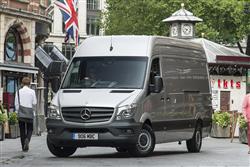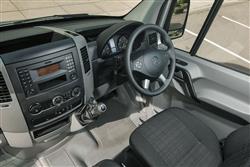HOW TO GET A MINT SPRINT (some text hidden) --NONE--
By Jonathan Crouch
Introductionword count: 74
The Mercedes Sprinter is a large van with a big heart. When the second generation version was launched in 2006, that heart meant a class-leadingly efficient range of diesel engines that really took the fight to large van rivals. These refined units offered potentially large efficiency savings to businesses who appreciated this model's spacious, practical, high quality virtues. It ought to stack up well as a used buy too. Does it? Let's find out.
Modelsword count: 15
Panel van (2.1 CDI diesel - 95, 129, 163bhp / 3.0 V6 CDI diesel 190bhp)
Historyword count: 158
When it comes to large vans, one stands above all others across Europe: this one - the Mercedes Sprinter. Nearly a million examples of the second generation version of this nodel were made. This vehicle, launched in 2006, shared its design with arch-rival Volkswagen's Crafter - but not its engines. A new generation of Euro5-compatible CDI diesel units introduced in 2009 set running cost and efficiency standards that rivals struggled to better. Amongst these were vehicles like the Vauxhall Movano/Renault Master design and the Peugeot Boxer/Fiat Ducato/Citroen Relay collaboration, plus of course that VW alternative. But generally, all played catch-up behind this Sprinter in the large van sector. Mercedes was first to introduce a V6 engine to this segment, first to introduce Stop-Start technology to cut costs and was a leader in promoting natural gas power as an alternative. This MK2 Sprinter was facelifted in 2015, then replaced by a third generation model in the Spring of 2018.
What You Getword count: 1240
The look of this MK2 Sprinter changed little in its lifetime, but then large vans in this class don't tend to be bought for aesthetic reasons. The imposing twin-slat grille complete with its large Three-Pointed Star is sufficient to make the point that yours is a business not prepared to compromise on quality. And to emphasise the practical side, there are heated wide-angle mirrors and a useful step in the bumper from which it's easier to climb up and clean the tinted windscreen. Minor front end changes featured as part of the 2015-era facelift. Inside, the links to Mercedes-Benz passenger cars are instantly apparent. The clear, classily penned instruments, the ventilation controls and the stereo installations are all borrowed direct from models like the B-Class and A-Class. This means that the quality is beyond the level that you might expect in a panel van of this kind. Elsewhere, care was taken to keep things tough and hardwearing while retaining the plush ambience. At the wheel, the seats feel supportive and while the steering column isn't height adjustable, the optional 'Comfort' driver's seat that most original owners specified offers the option to alter the angle of the seat cushion. A three-seater cab is standard and features a middle seat backrest that can fold down and turn into a handy table that can be used to complete paperwork and also features a couple of cupholders and a pen tray. Other storage areas dotted around the cabin include lipped shelves above the windscreen on both driver and passenger sides, a shelf behind the instrument binnacle, large door bins which though a little narrow do have a moulding that will accommodate a flask or a bottle of water, a lockable glovebox and a dash-top shelf that will swallow an A4 clipboard. Nearby is a clip that can hold loose paperwork and there are coat hooks behind the seats. As for cupholders, well, there's one built into this passenger-side dash-top shelf, another as part of a pull-out ashtray and one more to the right of the instruments. At the business end, we like the way that the rear doors can be swung through 270-degrees and latched against the sides. The rear door aperture is 1565mm in width, while its height is either 1540 or 1840mm, depending upon your choice of roof height. The rear loading height can be as little as 689mm and a useful rear step (where fitted) is a good halfway point to rest heavier loads before hauling them up to final floor-height. Ultimate loading capacity does of course depend upon your choice between four body lengths, the Short one that has a loadspace length of 2600mm, the Medium version that boosts this to 3265mm and the long or extra long options with their extended overhangs that boost total loadspace length to either 4300mm or an enormous 4700mm. The compact and long body style options sit on a standard wheelbase of 3,250mm or 3665mm, but the lengthiest 'long' or 'extra long' models get an extension between the wheels to 4,325mm. If it's ultimate cargo capacity you want though, you'll need to find somewhere to park either High or Super High roof models which boost the standard 1650mm loading height to either 1940 or an enormous 2140mm. As you would expect, these heightened roofs make a big different to cargo capacity, boosting the load bay volume up from the Short length Standard roof model's 7.5 cubic metres to a truly cavernous 17 cubic metres. Plus near vertical interior walls and levelled-off wheelarches mean that you can make the very most of the space on offer. Permissable gross vehicle weights range from 3.0 to 5.0 tonnes. With corresponding payload capacities of between 730kgs for the smallest Sprinter to 2,510kgs for the largest, this LCV should accommodate just about anything most businesses can throw at it. One dimension's the same for all Sprinters, however, and that a 1780mm loading width that narrows to 1350mm between the wheelarches - easily wide enough to slide in a Europallet, something you can also do through this sliding side door. This can optionally slide open automatically via the remote central locking and has a door aperture width of 1300mm and a corresponding height of between 1520 and 1820mm, depending upon the roof height you've selected. Once everything's in, you'll be pleased to find that there are three interior lights provided for night-time work and that there are eight tie-down points in the floor to secure potentially wayward loads. Should you forget to use them and everything slides forward, you'll be glad of the full-height bulkhead. All Sprinter panel vans come equipped with a high density, anti-absorbant ply-lined floor but to add to that, most original owners specified a ply-lining kit to protect the interior sides. Others also ticked the box for a useful shelf above the cab that gives you somewhere to stow load lashing straps and the like. Keeping costs down will be a major priority for potential owners, people who'll like the clever Assyst service computer that was standard on all Sprinters and is able to detect when a garage visit is required, taking into account the vehicle's actual usage. The likely average oil change interval is reckoned to be around 25,000 miles, with servicing intervals set at around 50,000, though some operators will be able to extend these intervals by up to 6,000 miles or more with careful use. Residual Values are predictably class-leading. In practical terms, you're looking at about 40.5p per mile for a long-bodied High-roofed 313CDI Sprinter as opposed to 42p per mile for an equivalent Ford Transit. All of this is of course is further aided by this LCV's legendary reliability, underlined by over 7 million miles of testing: it uses an an engine that's been developed to run for a minimum of 220,000 miles. As for day-to-day operating costs, well these were reduced significantly by the cleaner Euro 5 engine range introduced back in 2009 that keeps emissions down to between 222 and just over 260g/km depending on model. Expect fuel consumption of between 28 and 31mpg on the combined cycle. If you're familiar with the operating costs of an older pre-Euro5 Sprinter, then Mercedes reckons that the post-2009 one should save you between 55 and 165 gallons of fuel a year in comparison to its predecessor on a 30,000 annual mileage, depending on the variant chosen. Up that annual mileage to 90,000 and the annual savings would increase to anything between 165 and 500 gallons. To get towards the upper segment of those potential savings, then you'll to get a Sprinter that was originally specified with the extra cost EcoStart system that cuts the engine when you don't need it at the lights or in urban traffic. Operators have found that this system can cut their fuel bills by up to 24% or more - and that they more than got this feature's extra cost back in higher residuals at the end of the ownership period. To really maximise on lower running costs, you'll need to get a Sprinter originally specified with Mercedes' BlueEfficiency package. As well as EcoStart, this includes battery management, low rolling resistance tyres, an ECO power steering pump, a gearchange indicator, a controlled fuel pump and a number of mechical modifications. You could potentially further increase your savings by taking advantage of the fact that this vehicle will run on a proportion of up to 10% biodiesel.
To see the full road test text contact us on 0330 0020 227
Pictures (high res disabled)
.jpg)
.jpg)
|
.jpg)
|
.jpg)
| |||
.jpg)
|
.jpg)
|

| |||

|
Scoring (subset of scores)
Category: Vans
| Performance | |
| Handling | |
| Comfort | |
| Space | |
| Styling, Build, Value, Equipment, Depreciation, Handling, Insurance and Total scores are available with our full data feed. | |



